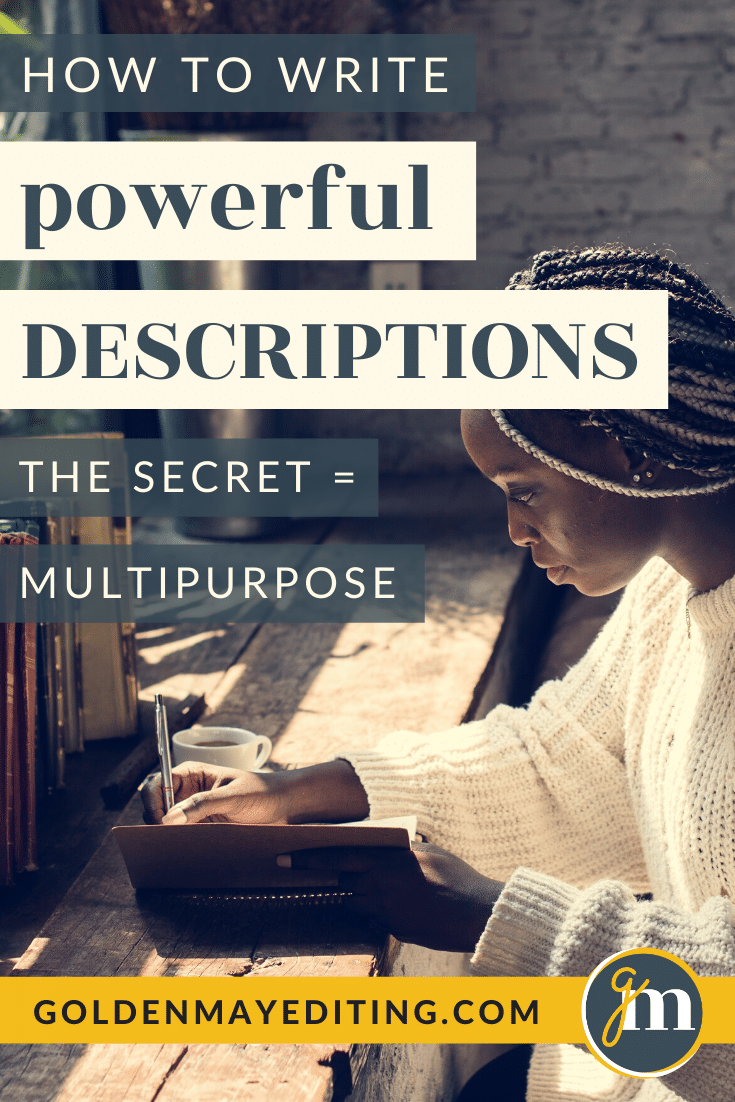When we lose ourselves in novels, it’s as much due to the author’s deft weaving of descriptions as it is the story itself. Descriptions are what bring a story to life. When I close my eyes, I can still see and smell the beach where Kya lives in Where the Crawdads Sing. I can still picture the first time Elias meets Laia in An Ember in the Ashes. I can still lose myself in the halls of J. K. Rowling’s Department of Mysteries. However, descriptions aren’t just about picturing or visualizing things. We remember them long after the story is over when we feel them.
Yet, balancing the emotional impact of description is often nothing short of a headache. If you use too much description you risk boring or overwhelming your readers. But at the same time, if you let readers ‘fill in the holes’, you’re worried you’ll have too little description and your readers will be wandering around in the dark.
To write purposeful and powerful descriptions that entice readers, use your descriptions as opportunities to draw meaning from what’s happening in the moment in your scenes.
The best way to do this is to use your descriptions to kill two birds (or more) with one stone. Instead of just describing something or someone for the sake of visuals, use your descriptions to reveal to the reader how your character is feeling, who they are, and what they want. By showing rather than telling, you will inevitably keep your descriptions brief and meaningful (and avoid those pesky info dumps!). You’ll engage, rather than bore or confuse, your readers.
All descriptions should serve multiple purposes: describe the story world + at least one of the following
1. Reveal the character’s fears or motivations.
As humans, we notice the things around us that matter to us in the moment. Our brains filter out the rest. Put yourself in your character’s shoes: What do they want in the story moment? Based on their desires or fears, what are they likely to take note of in their surroundings? What are they likely to ignore? How is their Internal Obstacle—their flawed belief about the world that is clouding their judgement—influencing what they see or feel?
2. Establish the character’s mood and voice.
Humans don’t walk around like video cameras. Readers don’t need or want a play-by-play of the details of each person, place, or thing. In real life, everything we take note of is tied to our present emotions and immediate goals. What is your character feeling in the moment on the page? (And therefore, how should the reader feel?) What are they noticing in their external environment that is making them feel or react both physically and emotionally? How do those feelings color your character’s observations of the people, places, and things around them?
3. Set pieces or foreshadowing for later conflict or reveals.
There’s a famous Chekov quote that states, “If you say in the first chapter that there is a rifle hanging on the wall, in the second or third chapter it absolutely must go off. If it’s not going to be fired, it shouldn’t be hanging there.” What he’s saying, essentially, is that you should never include irrelevant details. As we read, we file away all details, believing they’ll later prove important. If your details never pay off, your readers will start to distrust you and start skimming your descriptions—possibly missing important set pieces they need to understand later parts of our story. While intended as a warning, this quote is also a tool. Look at your descriptions as an opportunity to set up details that won’t be important until later. (Hint: if you wrap these descriptions in the character’s motivations and voice, your readers will remember it AND not suspect your foreshadowing.)
Examples of Powerful Descriptions
CHARACTER:
Harry Potter and the Prisoner of Azkaban by J. K. Rowling
With a snap, the man in the shadows closed the door behind them. A mass of filthy, matted hair hung to his elbows. If eyes hadn’t been shining out of the deep, dark sockets, he might have been a corpse. The waxy skin was stretched so tightly over the bones of his face, it looked like a skull. His yellow teeth were bared in a grin. It was Sirius Black.
Why this works: Harry spends most of The Prisoner of Azkaban wishing he could kill Sirius Black. When he finally lays eyes on the man, he doesn’t see the poor wasted soul he later comes to love. Instead he sees Sirius through the lens of already being dead—he dehumanizes Sirius with the words ‘corpse’ and ‘skull’ because he’s subconsciously preparing for the very next moment when he is so angry he wants to kill Sirius.
Purposes: Description, Mood, Motivation
CHARACTER:
An Ember in the Ashes by Sabaa Tahir
The tapping grows insistent, and I turn, intending to tell off the Cadet. Instead, I’m faced with a slave-girl looking up at me through impossibly long eyelashes. A heated, visceral shock flares through me at the clarity of her dark gold eyes. For a second, I forget my name.
I’ve never seen her before, because if I had, I’d remember. Despite the heavy silver cuffs and high, painful-looking bun that mark all of Blackcliff’s drudges, nothing about her says slave. Her black dress fits her like a glove, sliding over every curve in a way that makes more than one head turn. Her full lips and fine, straight nose would be the envy of most girls, Scholar or not. I stare at her, realize I’m staring, tell myself to stop staring, and then keep staring. My breath falters, and my body, traitor that it is, tugs me forward until there are only inches between us.
It’s the way she says my name—like it’s something to fear—that brings me back to myself. Pull it together, Veturius. I step away, appalled at myself when I see the terror in her eyes.
Why this works: While, at its core, this is a description of Elias’s immediate attraction to Laia when he sees her the first time, it actually reveals a lot about who Elias is. His immediate analysis of her lack of slave qualities shows a careful attention to detail. The fact that he notices other people noticing her shows his concern for what her beauty might mean for her safety. And lastly, the way he’s appalled at her reaction to him shows how disgusted he is with his title, and how much he doesn’t want to be the monster that she clearly believes he is.
Purposes: Description, Voice, Motivation
SETTING:
The Poppy War by R.F. Kuang
And then, at last, they were through the gates.
The downtown marketplace was an assault on the senses. Rin had never seen so many people or things in one place at one time. She was quickly overwhelmed by the deafening clamor of buyers haggling with sellers over prices, the bright colors of flowery skeins of silk splayed out on grand display boards, and the cloyingly pungent odors of durian and peppercorn drifting up from vendors’ portable grills.
“The women here are so white,” Rin marveled. “Like the girls in wall paintings.”
The skin tones she observed from the caravan had moved up the color gradient the farther north they drove. She knew that the people of the northern provinces were industrialists and businessmen. They were citizens of class and means; they didn’t labor in the fields like Tikany’s farmers did. But she hadn’t expected the differences to be this pronounced.
Why this works: Rin, an orphan girl from a small village, has just tested into the country’s most prestigious military academy. This is the first time she sets foot in the capital. First we’re shown how overwhelmed Rin is feeling by the chaos of it all. We can hear the clamor, see the colors, and smell the pungent odors. Then Rin hones in on how different people look from her, which highlights her growing fear that she won’t fit in at school.
Purpose: Description, Mood, Fears
SETTING:
The Sisterhood of the Traveling Pants by Ann Brashares
Planes are so clean. Carmen liked that. She liked the orderly, corporate smell and the sheer number of wrappers in her snack basket. She admired the snack itself, the miniature apple. Exactly the right size, shape, and color. Kind of fake, but reassuring at the same time. She tucked it into her bag. She’d save a little order for later.
She’d never been to her dad’s apartment—he’d always come to see her instead. But she’d imagined it. Her dad wasn’t a slob, but he didn’t have that second X chromosome either.
Why this works: Carmen is on a plane headed to spend the summer with her dad for the first time. She’s super excited to spend time alone with him, but she’s also nervous. You can tell just from her description of the plane that she is mentally preparing for the disorder she expects to find. What’s fantastic is that this is a set up for the following scene when she learns that her father lives with a woman she didn’t know about, in a fancy, clean, suburban house. It’s the exact opposite of what she imagined, and suddenly the ‘kinda fake’ aesthetic that reassured her on the plane becomes her worst nightmare.
Purpose: Description, Mood, Voice, Motivation, Foreshadowing
As you’re writing, if your description isn’t doing at least one thing on this above list, see if you can make it do so. Otherwise, cut the description all together.
Practicing this diligence will both tighten and deepen your prose.
Happy writing!









Thanks,
I am ever so learning from all the free sources I can find.
Thank you for the examples that made what you were teaching
me so much clearer and understandable , especially in the context
of the overall writing story picture.
warren